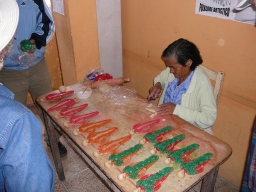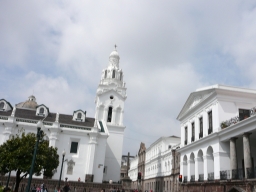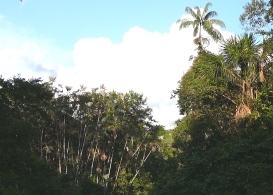This site will look better in a browser that supports web standards, but it is accessible to any browser or Internet device.
KENDRIC C. SMITH'S HOME PAGE
![]()

40 YEARS IN ACADEMIA
- HOME PAGE
- CURRICULUM VITAE
- SCIENTIFIC
COMMUNITY SERVICE - BIBLIOGRAPHY
- RESEARCH HIGHLIGHTS
- SCIENTIFIC HISTORY
IN RETIREMENT:
A COMPUTER NERD and BIRDER
October 2007
We went to Ecuador on a birding trip with the Sierra Club. We arrived a day early and participated in some pre-trips in and around Quito, the capital of Ecuador.On the first day we drove 22 km north of Quito to the Mitad del Mundo (middle of the world) where the latitude was determined to be zero by early French scientists (1700). This was close, but the true "middle of the earth" is a few hundred km away at the Intinan Solar Museum. This location was determined by GPS.
They had a portable sink at the Intinan Solar Museum. When it was on the equator, the water went straight down, i.e., no whirlpool. When the sink was moved just 5 feet south, the drain whirlpool went clockwise. When the sink was moved about 5 feet north of the equator, the drain whirlpool went counter-clockwise (Coriolis Efftct?). However, the Internet says that this is a hoax. It depends upon how the water is poured into the sink. Oh, well. It was a remarkable "demonstration". I tried it at home, and could make the water do what I wanted it to do.
Then we drove to the Pululahua Crater, only a few miles north for lunch. Unfortunately, the fog came in and filled the crater, so we did not hike down.
The next day (Saturday, October 13, 2007) we spent time at Otavalo, a trade center (street fair) for crafts a little north of Quito. We had lunch at Mirador Rio Blanco, where they had an Andean Flute Band playing music for us. That evening, since it was my 81st birthday, I bought wine for the group.
Our group (12 people) was from California, except for one person from Colorado. Carol Dienger was the Sierra Club leader, and Charlie Gomez (Costa Rico) was the excellent bird guide.
The first official day of the trip was spent on a city tour of the old town of Quito. We visited churches, museums, and the capital building. Since it was Sunday, cars were not allowed, so we could stroll about safely. We ended the day with a tour of the gallery of the works of Oswaldo Guayasamin, one of Latin America's most influential painters. The paintings were huge, and very dramatic.
The first day of birding was at Yanacocha Reserve (~13,000 ft) on the slopes of Volcano Pichincha, a few miles outside of Quito. It is a montane cloud forest, and a "hummingbird-lovers paradise". When we entered the lodge, we had to take off our shoes and wear the blue paper slip-ons that people wear in surgery.
Then we dropped down to the Tanayapa Valley and the Bellavista Cloud Forest Reserve (~7500 ft), a lower montane cloud forest. The house that we were in was a tower of bamboo. We had a really steep staircase to get to the rooms from the dining room, and the walls were just slats of bamboo, so that even a whisper was audible in the next room. One couple from our group is returning there for a post trip.
Then we drove to the Mindo-Nambillo Protected Forest to look for and find the Giant Antpitta (named Maria). The local "ranger" called in Maria and fed her worms. They also had a Cock-of-the-Rock lek (courtship). The birds here are bright red, while the ones we saw in Peru were orange. It is a question of subspecies on the east versus the west side of the Andes. Then we headed back to Quito.
The next day, we left most of our luggage at the hotel, and caught a local plane to the frontier oil town of Coca, which is on the River (east of Quito). There we caught a covered longboat canoe with two big motors to take us for about 2 hours to a depot on the Napo River, where we changed to longboats that had to be paddled (2 in back and one in front) to reach the Napo Wildlife Center (~1.5 hr) in the reserve (no motors allowed). There we birded along the tributaries and trails, and hiked for an hour to a lookout tower that is above the trees (about 250 steps as I recall). There was also a shorter lookout tower above the dining room.
We also went to two Parrot Licks. These are cliffs of special clay that the parrots eat to detoxify some of the food that they eat. It was quite a show.
Then we retraced our "steps" in a paddle canoe, and a motorized canoe to return to Coca, and our flight to Quito. The hotel had brought our big suitcases to us at the airport. We got out our winter clothes, and put away our jungle clothes, and took our bus to the crest of the Andes at Papallacta Pass (~13,000 ft). It was so cold and foggy and windy that we did not see many (any?) birds.
We drove down to 6500 ft to Termas de Papallacta, a hot springs resort, which is about 40 miles from Quito. We went birding up the mountain the next day before breakfast, and saw the Andean Condor, in fact, six all together, and once I had four in my binoculars. There were a number of juveniles, so it was probably a family. Some of our group had taken a rest and did not join us before breakfast, but our guide was able to get the birds in a scope from the hotel, so everyone saw the Condors.
We birded along the roads, and had lunch at Guango.
Then we went to Cabinas San Isidro (Andean Cloud Forest) and birded the trails and roads. We saw the White-bellied Antpitta, when the "ranger" called him out for worms. Unfortunately, my only looks at a Highland Motmot was one that crashed into our cabin and died. It is a beautiful bird.
Our last adventure was to climb near the base of the glacier on Antisana, where we had the best lunch on our trip at an old hacienda well above 13,000 ft. We saw a lot of special birds that live in what can be considered a hard area to survive in. While we were there we had snow and hail. It was quite a change from the jungle.
Then it was back to Quito to catch our flights home.
It was a very nice trip. We saw a lot of different habitats, and we saw a lot of birds. I saw 295 species, of which 145 were life birds, i.e., not seen before.
USE THE BACK BUTTON TO RETURN





























































